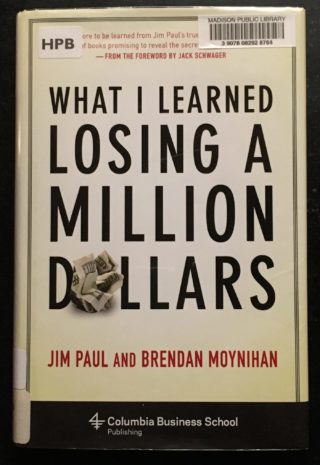What I Learned Losing A Million Dollars by Jim Paul and Brendan Moynihan
In life we learn much more from our mistakes than from our successes. Yet we tend to focus on those individuals who have been successful. Did they get lucky? Did they hit the market at a good time? Sometimes it’s hard to tell.
With that in mind I was very interested to read this book. As the old saying goes (and is also mentioned in this book), the smart person learns from their mistakes, but the wise person learns from the mistakes of others.
The first half of the book covers the story of Jim Paul and how he became wealthy trading commodity futures, then lost it all. This is important background, but the real value in the book comes in the second half where he does a deep analysis of where he went wrong and how it applies to all investors.
Some of the key learnings include:
Successful investors don’t agree on how to make money. There are lots of ways to do it and different ways work for different people.
Successful investors do agree that the most important thing is to not lose money, or at least to control your losses.
(When you think about this, it makes sense. It takes a 100% gain to overcome a 50% loss. And another old saying: The market takes the stairs going up but takes the elevator going down.)
The authors describe the human characteristics that cause us hang on to losing positions, and I won’t repeat that here. Read the book, this is valuable information.
The book differentiates the types of participation in the market. Which type you are depends on your behavioral characteristics.
- Investing
- Trading
- Speculating
- Betting
- Gambling
It’s important to understand which type of participant you are, and the book gives definitions for all of these.
Investing is parting with capital in the expectation of safety of principal and an adequate return in the form of dividends, interest, or rent. Investing is characterized by a long time horizon. Buying stocks with the intention of holding them indefinitely or buying a bond and holding until maturity are two examples.
Trading is an activity where the trader wants to take advantage of a difference in the buy and sell price, over a very short time frame. Professional traders do something called “making a market” where they try to balance buying and selling to stay net flat.
Speculating is basically buying for resale rather than for use as income. The speculator is looking for capital appreciation.
Betting is an agreement between two parties about the outcome of an uncertain event. A bet is about being right or wrong and having a winner and a loser. The bet is placed for the satisfaction of being right.
Gambling is a derivative of betting. Gambling can involve a game or event of chance or a game that involves both skill and chance. What differentiates it from betting is the attitude of the participant. Bettors want to be right, gamblers enjoy the game and want to participate whether they win or not. According to the book’s definition, a “professional gambler” is actually someone who takes calculated risks, and who is actually more like a speculator.
The major recommendation is to have a plan for each position you take in the market, before you take that position. The steps to create a plan are:
- Decide what type of participant you want to be (from the list above).
- Select a method you are going to use to analyze this position.
- Develop rules: If this happens then I will do this…
- Establish controls: How will you control your losses?
- Put this all together and formulate your plan.
Finally, knowing why the market is moving doesn’t matter. You can’t predict the market, but you can control your losses.
(I’m often amused when every market move has an associated reason in the press. Sometimes the reasons make sense but often they seem to just be made up.)
I consider this a very valuable book and I highly recommend it.
